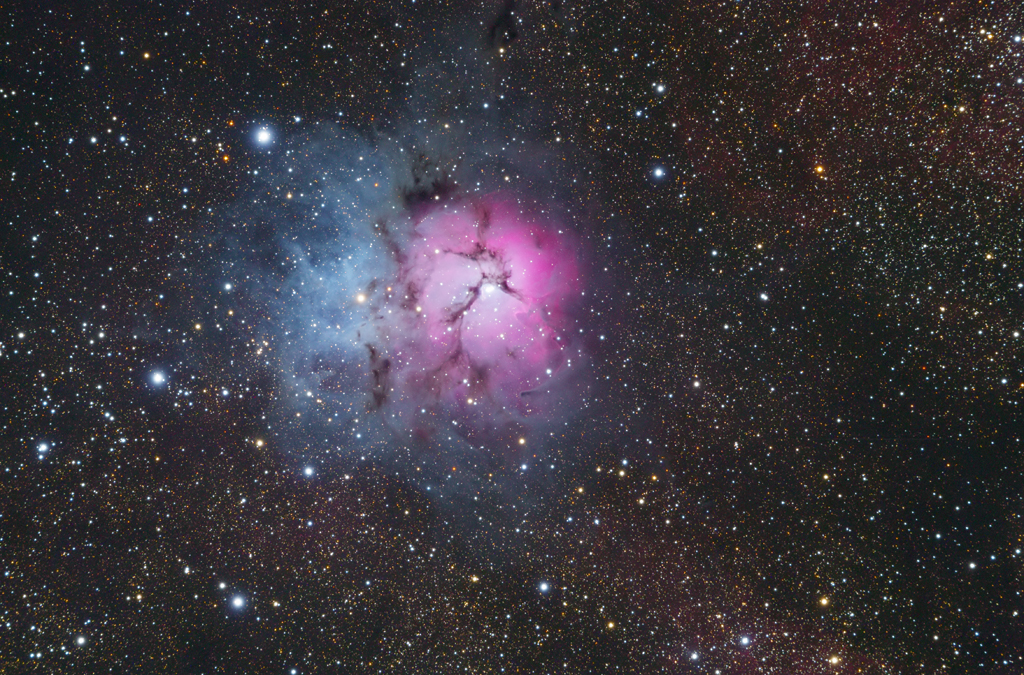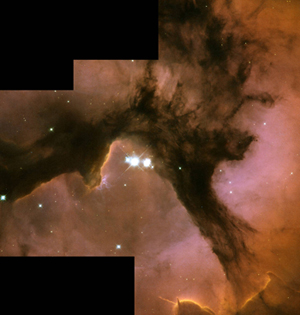 |
CHAMÄLEON + ONJALA OBSERVATORY DeepSky | SITEMAP HOME CHAMÄLEON |
|
 |
|||
| « back to overview Nebula | Load higher resolution (1800 x 1200 Pixel 2500 x 1700 Pixel) | Object description |

Embedded in a large molecular cloud lies Messier 20, the Trifid Nebula in the constellation Sagittarius. It is a large, active star-forming region and a mixture of reflection nebulae (blue), emission nebulae (red), and dark, cold dust and gas (black). These dark dust bands crossing the reddish, southern part of the nebula also led to the name Trifid Nebula (three-part nebula). Astrophysicists today agree that the Trifid Nebula is one of the youngest star forming regions in the Milky Way.
If you look at the southern, reddish glowing H-II region, you will notice that it is approximately round. Astronomers call such a structure a "Strömgren sphere." In the center is the star HD 164 492 with a magnitude 7 brightness. It is a double star system. The main component is a luminous blue giant star of spectral class O7. It has a temperature of about 35 000 K and is about 20 000 times more luminous than our Sun. By emitting enormous amounts of ultraviolet radiation it is the main ionization source which makes the hydrogen gas glow reddish.
The companion star of HD 164 492 is also a blue supergiant of spectral class A2. It is significantly cooler than the main component and contributes little to the ionization of the hydrogen gas. Looking more closely at the center, a small cluster of 6 stars can be seen around HD 164492.
The northern part of the Trifid Nebula is clearly blue, because here the reflection components of the light are very strong. In the center of this reflection nebula is the star HD 164 514, also a blue supergiant. With a spectralty A7 it is too cool to excite the surrounding gas to emit.
Our image clearly shows that the Trifid Nebula is surrounded in its entirety by blue luminous reflection nebulae. For example, Messier 20 is a very large, round reflection nebula that also partially contains a red luminous H II region because of the young, hot star HD 164492. The H-II region contains a large number of T-Tauri type variable stars. In addition, images with large telescopes show numerous protostellar condensations, as well as numerous globules with starless centers, in which matter is gradually condensing, so that the next generation of stars is just forming here.
 |
« This somewhat " ghostly" image shows the
center of the Trifid Nebula and the three wing-like bands of thick dust for
which the nebula was named, taken with the Hubble Space Telescope. A group of
recently formed, massive, bright stars at the center of the nebula is clearly
visible. These stars release a flood of ultraviolet radiation that dramatically
affects the structure and evolution of the surrounding nebula. Star formation
no longer occurs in the immediate vicinity of this group of bright stars
because their intense radiation has blown away the gas and dust from which new
stars form. « Load large image of the central region from the Trifid Nebula (Credit: NASA, ESA and the Hubble Heritage Team (AURA/STScI)). The distance of the Trifid Nebula to the solar system does not seem to be known exactly. The information varies between 3000 and 9000 light years. In general, the distance is given as 5200 light-years. In terms of area, M20 fills about 40 light-years. Messier 20 was discovered by Charles Messier on June 5, 1764. A high-resolution image of the Trifid Nebula taken with the 17" Planewave from Rooisand is shown here. More information about the Trifid Nebula from ESO at this URL. |
 |
 |
 |
 |
 |
 |
 |
| Sonne | Mond | Sonnensystem | DeepSky | Weitwinkel | Verschiedenes | Spez. Projekte |